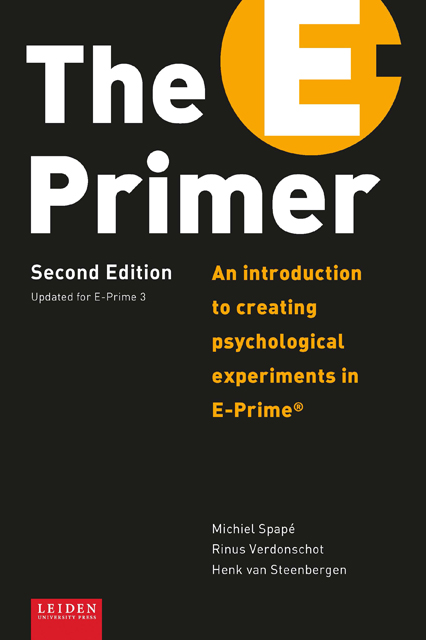Book contents
- Frontmatter
- Table of Contents
- Preface to the Second Edition
- Preface to the First Edition
- Introduction
- Chapter I E-Prime at a glance
- Chapter II List Attributes and Slides
- Chapter III Sound, movies, hardware, and nested Lists
- Chapter IV Beginning programming in E-Prime
- Chapter V Decision making in E-Basic
- Chapter VI Loops and Arrays in E-Basic
- Chapter VII Interactions between Slide objects and the Mouse
- Chapter VIII Various Input/Output devices
- References
- Appendix: Overview of available E-Objects
- About the authors
- Index
Chapter IV - Beginning programming in E-Prime
Published online by Cambridge University Press: 22 November 2022
- Frontmatter
- Table of Contents
- Preface to the Second Edition
- Preface to the First Edition
- Introduction
- Chapter I E-Prime at a glance
- Chapter II List Attributes and Slides
- Chapter III Sound, movies, hardware, and nested Lists
- Chapter IV Beginning programming in E-Prime
- Chapter V Decision making in E-Basic
- Chapter VI Loops and Arrays in E-Basic
- Chapter VII Interactions between Slide objects and the Mouse
- Chapter VIII Various Input/Output devices
- References
- Appendix: Overview of available E-Objects
- About the authors
- Index
Summary
In this chapter, you will learn
So after the last chapter, you know how to test your long term memory. But chances are that if someone talks about having a ‘good memory’ or a ‘bad memory’, they actually mean their working (or short term) memory. Because short term memory is, well, short, you could set up a challenge with your friend and find out in a relatively short amount of time who has the better memory. After this chapter you will be able to do just that, because you are now going to learn how to program a working memory test. Unlike the previous chapter, we won't be working with complicated lists. Instead we’re going to give you a chance to master E-Prime's programming language, E-Basic (which is essentially an old version of Visual Basic for Applications – the same stuff that runs Excel macros, amongst other things).
This chapter provides a psychologist-friendly introduction to Basic programming by first introducing several important Basic programming concepts such as variables, operators, mathematical functions and string functions. You will also learn how to integrate this programming knowledge into your E-Prime experiments and, finally, how to use it to perfect your experiments down to the minute details. Programming has a bad reputation: “geeky”, “difficult” and “boring” are words that came up in the E-Primer Marketing Department's student focus group. We can't really help the geekiness, but we’ll try to get round the difficulties and boredom, because in the end, some things just can't be done without some Basic programming knowledge. If you read carefully through this chapter, digest the theory and carry out all the examples, the tutorial and the exercises, you will be ready to roll. If you ever get stuck with programming, though, you can always ask someone. A great place to turn for help is the online E-Prime discussion group (http://groups.google.com/group/e-prime/). You can also try posting on the E-Prime support forum(https://support.pstnet.com/hc/en-us/community/topics).
E-Basic in E-Prime
All this dragging objects about is fine and dandy, but it doesn't quite feel like programming, does it? According to PST, the developers of E-Prime, E-Prime doesn't require programming, or “using code”.
- Type
- Chapter
- Information
- The E-PrimerAn Introduction to Creating Psychological Experiments in E-Prime, pp. 111 - 134Publisher: Amsterdam University PressPrint publication year: 2019



